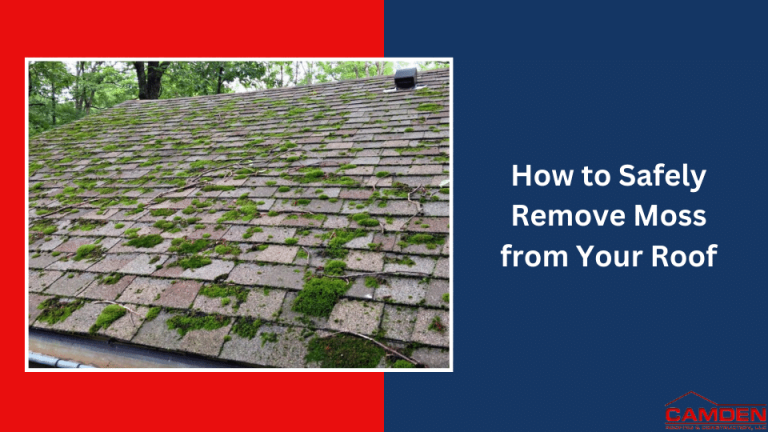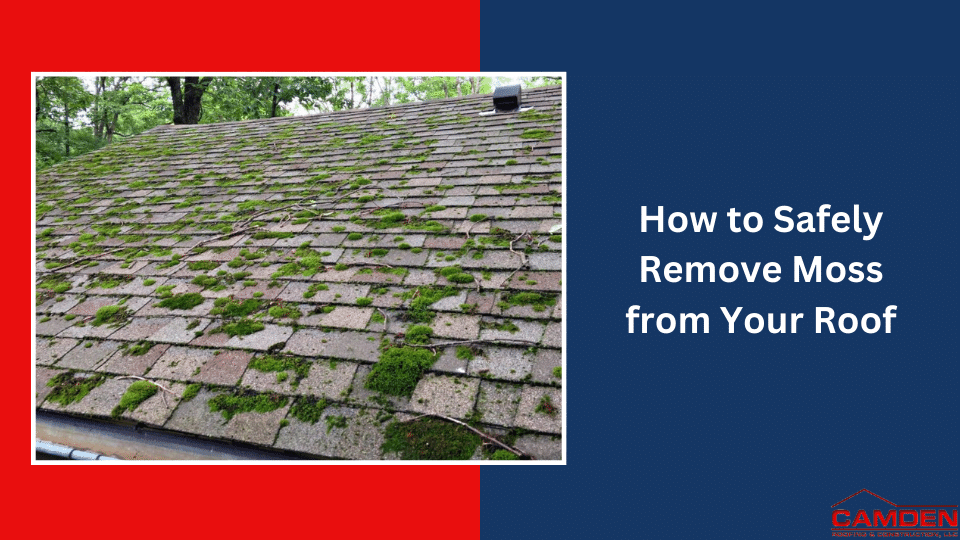How to Safely Remove Moss from Your Roof with Camden Roofing & Construction. Moss-covered roofs may look charming in a fairytale forest, but in reality, they can spell trouble for your home. Moss not only affects your roof’s aesthetics but can also lead to serious damage if left unchecked. In this guide, we’ll explore the reasons for moss growth, its potential impact on your roof, and the safe and effective methods to remove moss while preserving your roof’s integrity.

Why Does Moss Grow on Roofs?
Moss is a type of non-vascular plant that thrives in damp, shaded areas. Several factors contribute to moss growth on roofs:
Shade: Moss prefers shady areas with limited exposure to direct sunlight. If your roof is surrounded by trees or other structures that create shade, it can provide an ideal environment for moss to flourish.
Moisture: Moss requires moisture to grow, so areas prone to rainfall, high humidity, or frequent dew are susceptible to moss infestations.
Poor Drainage: Roofs with inadequate drainage systems may retain excess water, providing a habitat for moss to take root.
Porosity: Some roofing materials, such as asphalt shingles, cedar shakes, and tile, can be porous and provide a suitable surface for moss to attach and grow.
Organic Debris: The accumulation of organic debris like leaves, twigs, and pine needles on your roof can create a fertile substrate for moss to grow.
Effects of Moss on Your Roof
While moss may seem harmless, it can have detrimental effects on your roof:
Granule Loss: Moss can trap moisture on the roof’s surface, causing shingles to deteriorate and lose their protective granules. Granule loss can shorten the lifespan of your roofing materials.
Shingle Damage: Moss roots can penetrate and lift shingles, causing them to become dislodged or cracked. This can lead to water infiltration and structural damage.
Excess Weight: As moss accumulates and retains water, it adds extra weight to your roof. Over time, this added weight can stress the roof structure and compromise its integrity.
Blocked Gutters: Moss debris can wash into your gutters, leading to clogs and preventing proper drainage. This can result in water overflow and damage to your home’s foundation.
Safe Methods for Moss Removal
When dealing with moss on your roof, it’s crucial to prioritize safety and take steps to preserve your roof’s integrity. Here are safe methods for moss removal:
Manual Removal: Carefully use a long-handled scrub brush or a moss scraper to manually remove moss from the roof’s surface. Work gently to avoid damaging shingles. Wear appropriate safety gear, including non-slip footwear, gloves, and eye protection.
Soft Washing: Soft washing is a low-pressure method that uses a mix of water, mild detergent, and moss-killing chemicals to remove moss without damaging the roofing material. This method is effective and less likely to cause shingle damage.
Zinc or Copper Strips: Installing zinc or copper strips along the roof’s ridge can help prevent moss growth. Rainwater washes small amounts of metal particles down the roof, inhibiting moss growth as it flows over the strips.
Moss-Killing Products: Moss-killing products, available at home improvement stores, can be applied to your roof to kill moss. Follow the manufacturer’s instructions and use caution to avoid damaging vegetation below.
Professional Roof Cleaning: Consider hiring a professional roof cleaning service with expertise in moss removal. They have the experience and equipment to safely and effectively remove moss while preserving your roof’s integrity.
Preventive Measures to Keep Moss at Bay
Once you’ve removed moss from your roof, take preventive measures to discourage its return:
Trim Trees and Branches: Trim overhanging branches to reduce shade on your roof. Increased sunlight can help inhibit moss growth.
Clean Gutters Regularly: Keep your gutters free of leaves and debris to prevent organic matter from accumulating on the roof.
Install Proper Ventilation: Ensure your roof has adequate ventilation to promote airflow and reduce moisture buildup.
Apply Moss Inhibitors: Consider applying moss inhibitors or zinc or copper strips as a preventive measure to deter future moss growth.
Remove Overhanging Debris: Regularly remove leaves, branches, and pine needles from your roof to prevent organic material from providing a foothold for moss.
Schedule Regular Roof Inspections: Routine inspections can help identify moss growth in its early stages, allowing for prompt removal.
Safety Precautions
When removing moss from your roof, safety should be your top priority:
Use a sturdy ladder and have a spotter if necessary.
Wear appropriate safety gear, including non-slip shoes, gloves, and eye protection.
Be cautious when walking on your roof, as moss can make the surface slippery.
Avoid using pressure washers or abrasive tools, as they can damage shingles.
If you’re uncomfortable or unsure about removing moss, consider hiring a professional.
In Conclusion
Moss on your roof isn’t just an aesthetic concern; it can lead to significant damage if left unchecked. By understanding the causes of moss growth, its potential effects on your roof, and safe removal methods, you can take proactive steps to maintain your roof’s health and integrity. Regular inspections, preventive measures, and prompt removal of moss can help ensure your roof remains moss-free and continues to protect your home for years to come.
For more information, contact Camden Roofing & Construction, LLC in Charlotte and Raleigh, NC, at 919-729-5050.

